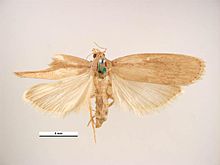- Rice Moth
-
- Not to be confused with the Rice Worm Moth (Apamea apamiformis) of family Noctuidae.
Rice Moth 
Scientific classification Kingdom: Animalia Phylum: Arthropoda Class: Insecta Order: Lepidoptera Family: Pyralidae Tribe: Tirathabini Genus: Corcyra
Ragonot, 1885Species: C. cephalonica Binomial name Corcyra cephalonica
(Stainton, 1866)Synonyms See text
The Rice Moth (Corcyra cephalonica) is a pyraloid moth of the family Pyralidae. It is – as far as is known – the only living species of the genus Corcyra.
This small moth can become a significant pest. Its caterpillars feed on dry plantstuffs such as seeds, including cereals (e.g. rice). Other recorded[1] foods are flour and dried fruits.
Synonyms
Other scientific names, now invalid, for the Rice Moth are:[2]
- Anerastia lineata Legrand, 1965
- Corcyra translineella Hampson, 1901
- Melissoblaptes cephalonica Stainton, 1866
- Melissoblaptes oeconomellus Mann, 1872
- Tineopsis theobromae Dyar, 1913
When describing his T. theobromae in 1913, Dyar established the genus Tineopsis. He overlooked, however, that this had already been proposed by Cajetan Freiherr von Felder for a (presumed) arctiid moth in 1861. Nonwithstanding that Felder's species is somewhat dubious and has not been identified in recent lists, Dyar's Tineopsis is a junior homonym and thus invalid in any case.[2]
Footnotes
References
- Grabe, Albert (1942): Eigenartige Geschmacksrichtungen bei Kleinschmetterlingsraupen ["Strange tastes among micromoth caterpillars"]. Zeitschrift des Wiener Entomologen-Vereins 27: 105-109 [in German]. PDF fulltext
- Savela, Markku (2009): Markku Savela's Lepidoptera and some other life forms – Corcyra. Version of 2009-APR-07. Retrieved 2010-APR-10.
Categories:- Galleriinae
- Agricultural pest insects
Wikimedia Foundation. 2010.
